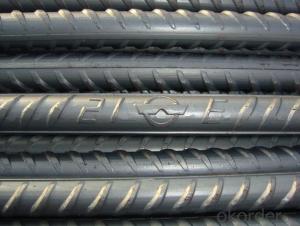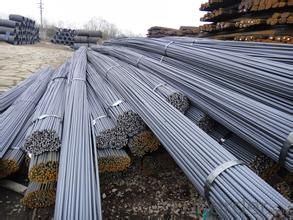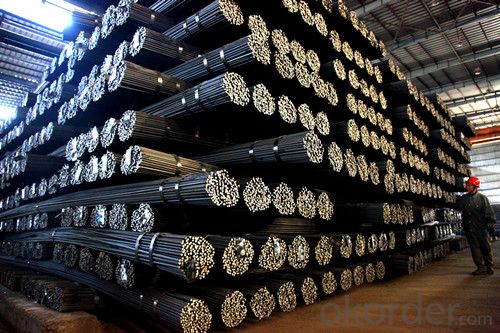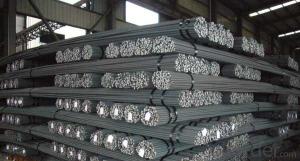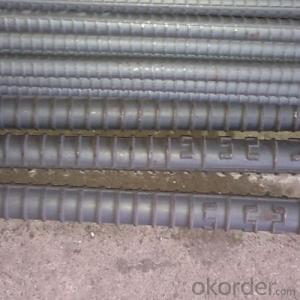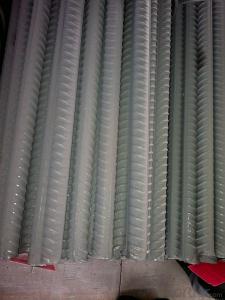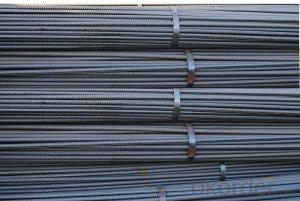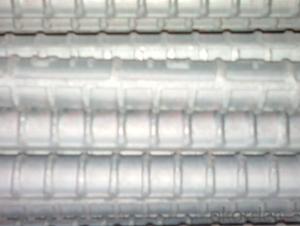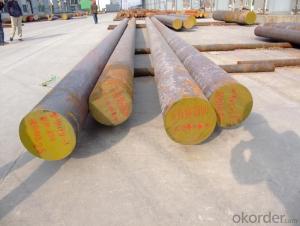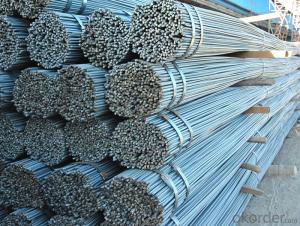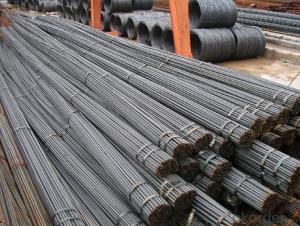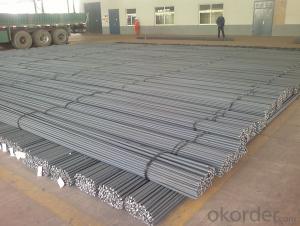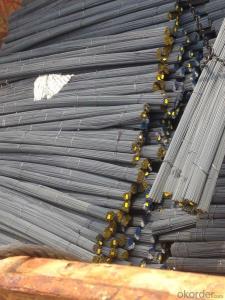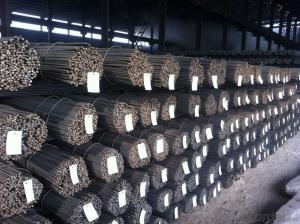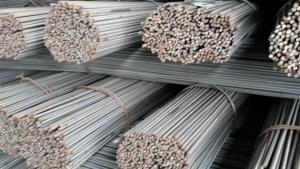Steel Rebar, Deformed Steel Bar, Iron Rods For Construction
- Loading Port:
- Shanghai
- Payment Terms:
- TT OR LC
- Min Order Qty:
- 100 m.t.
- Supply Capability:
- 1000 m.t./month
OKorder Service Pledge
OKorder Financial Service
You Might Also Like
deformed steel bar grade 40
material: HRB400, BS4449 GR460B
size: 8-36mmx12m.
short delivery time by bulk or container
deformed steel bar grade 40
material: HRB400, BS4449 GR460B
size: 8-36mmx12m.
short delivery time with bulk or container
packing: Mill standard export packing in bundles/coil, around 2tons/bundle.
country of Origin: China
delivery Time: Within a 35 days
Shipment: by bulk vessel or by container
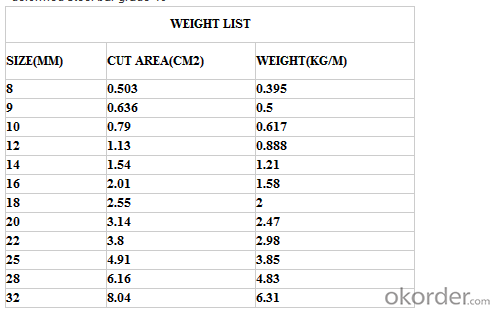
Leading goods:
section steel:angles,channels,I-beam,H-beam;
coils:cold/hot rolled coils,PPGI,galvanized coils,plate,checkered plate,cutting steel plate,steel strip;
wire rod:steel wire,deformed wire,bar;
pipe:seamless pipe,rectangular pipe,welded pipe,spiral welded pipe,pipe fittings;
stainless steel:steel sheets,stainless steel strips,stainless bar,stainless tube;
special:weathering steel,shipbuilding steel;
construction steel:C-channel,Z-channel,T-bar,high-speed divider plate,corrugated steel plate,steel grating.
Advantage:
We are the spot supplier, Six huge warehouses which can hold 20,000 MT goods.
It makes the cost lower than others,we can provide the competitive price for you.
Delivery time:
Normal sizes can be provided in 7days, the others should be ready in 30---45 days.
Further treatment:
We can offer cutting,painting,drilling holes,bending,threading, welding,galvanization,packing etc.
Security interest:
We have already passed the ISO9001, BV and SGS authentication which makes the quality secured.
If you have the interest in any of the products we can provided, pls don't hesitate to connect with me. Looking forward to cooperate with you.
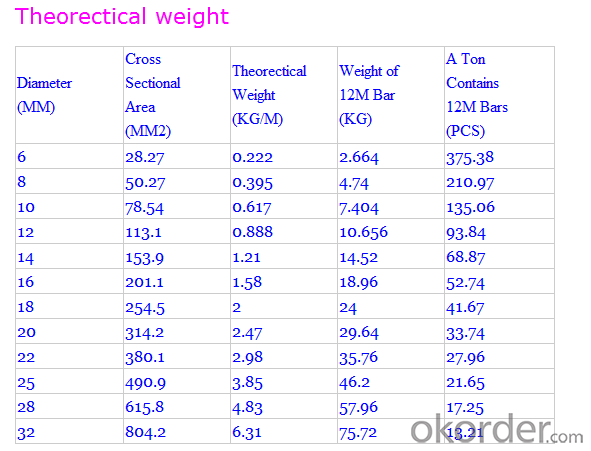
FAQ of Steel Deformed Bar
1. More than 10 years experience in this industry
2. 100,000 tons exporting per month
3. Professional foreign trade tea
4. OEM&ODM capacity
5. High quality assured & competitive price
6. Try our best to meet your needs & save your budget
7. Very popular in Southeast Asia, Africa, Mid-East and South America etc.
8. VIP membership system, first time customers and long-term cooperation customers can get extra discount on some products.
- Q: How do steel rebars affect the overall construction schedule?
- Steel rebars can have a significant impact on the overall construction schedule. They are essential components in concrete structures, providing strength and stability. However, their installation can be time-consuming as it requires careful placement and securing. Delays in rebar installation can potentially affect subsequent construction activities, such as concrete pouring and curing. Therefore, efficient planning and coordination of rebar installation are crucial to ensure the construction schedule remains on track.
- Q: How do steel rebars reinforce concrete?
- Steel rebars reinforce concrete by providing tensile strength to the concrete structure. The rebars are embedded within the concrete, and when the concrete undergoes tensile forces, the rebars resist the tension and prevent the concrete from cracking or breaking. This combination of concrete and steel rebars creates a strong and durable composite material that can withstand various types of loads and stresses.
- Q: Are there any limitations on using steel rebars in cold climates?
- Yes, there are limitations on using steel rebars in cold climates. The main limitation is the potential for the steel to become brittle and lose its strength in extremely cold temperatures. This can result in reduced durability and structural integrity of the reinforced concrete. To overcome this limitation, additional measures such as using low-temperature resistant steel or providing proper insulation and heating during construction may be necessary.
- Q: Are there any restrictions on the use of steel rebars in certain climates?
- Yes, there can be restrictions on the use of steel rebars in certain climates. In regions with high humidity or coastal areas prone to saltwater exposure, steel rebars are more susceptible to corrosion and rust. In such climates, additional protective measures like epoxy coating or using stainless steel rebars may be required to ensure the longevity and structural integrity of the reinforced concrete.
- Q: What are the guidelines for proper splicing of steel rebars in concrete structures?
- Ensuring the structural integrity and safety of concrete structures requires strict adherence to guidelines for splicing steel rebars. The following are key guidelines to follow: 1. Lap Splicing Length: The overlapping distance between rebars, known as lap splicing length, must adhere to the design plans or structural codes. Typically, minimum lap lengths are specified as a multiple of rebar diameter, such as 40 times for tension members and 25 times for compression members. 2. Cleanliness: Prior to splicing, rebars must be thoroughly cleaned to remove rust, scale, dirt, and other contaminants. Proper cleaning guarantees a strong bond during splicing. 3. Proper Alignment: Rebars to be spliced should be aligned correctly to maintain reinforcement continuity. Misalignment can cause stress concentration and weaken the structure. The bars should be parallel, evenly spaced, and in a straight line. 4. Splice Type: Various splice connections, including lap splicing, mechanical splicing, and welded splicing, are available. The choice of splice type should consider project requirements, structural design, and local building codes. 5. Reinforcement Bar Preparation: Before splicing, rebars should be prepared by removing scale, rust, and other contaminants. This can be achieved through brushing, grinding, or shot blasting. Additionally, the bar ends must be clean and free of deformations or irregularities. 6. Testing and Inspection: Regular testing and inspection are crucial to ensure the quality and integrity of spliced rebars. Non-destructive testing methods like ultrasound or magnetic particle testing can be used to check bond strength and ensure correct splicing. 7. Adequate Cover: Spliced rebars require sufficient concrete cover to protect against corrosion and fire. The concrete cover thickness should comply with local building codes and design specifications. 8. Proper Grouting: When using mechanical splices, ensure proper grouting or filling of splice sleeves or couplers with approved non-shrink grout. This ensures full load transfer and prevents rebars from moving or slipping. 9. Documentation: All splicing activities should be thoroughly documented, including the splice type, lap lengths, inspection reports, and any deviations from the original design. This documentation is important for future reference, maintenance, and regulatory compliance. These guidelines serve as general recommendations, and project-specific requirements and local building codes must always be followed. Consulting a qualified structural engineer or reputable construction professional is vital to ensure the highest standards of safety and compliance.
- Q: How are steel rebars measured and priced?
- Steel rebars are typically measured and priced based on their length, thickness, and weight. The length is measured in feet or meters, and the thickness is measured in inches or millimeters. The weight is usually given in pounds or kilograms. The pricing of steel rebars depends on current market conditions, including factors such as supply and demand, raw material costs, and manufacturing expenses. Additionally, any additional processing or customization requested by the customer may also impact the final price.
- Q: How much is the minus difference per ton of thread steel?
- Steel is commonly known as hot rolled ribbed bar, belonging to the small steel steel, mainly used for steel reinforced concrete structure frame.
- Q: How do steel rebars contribute to the overall resistance against natural disasters?
- Steel rebars contribute to the overall resistance against natural disasters by reinforcing structures such as buildings, bridges, and dams. They enhance the strength and stability of these structures, making them more resistant to earthquakes, hurricanes, and other natural calamities. Steel rebars increase the structural integrity, prevent collapse, and distribute the force of the disaster, reducing the extent of damage and protecting lives and property.
- Q: How do steel rebars affect the overall sustainability of bridge constructions?
- Steel rebars play a crucial role in enhancing the overall sustainability of bridge constructions. Firstly, steel rebars contribute to the longevity and durability of bridges. By reinforcing concrete structures, rebars help to distribute the tensile and compressive forces evenly, minimizing the risk of cracks and structural failure. This ensures that the bridge remains functional for a longer period, reducing the need for frequent repairs or replacements. Consequently, the use of steel rebars enhances the sustainability of bridge constructions by reducing the consumption of materials and minimizing waste generation. Moreover, steel rebars are highly recyclable, which further contributes to the sustainability of bridge constructions. At the end of a bridge's life cycle, steel rebars can be easily removed and recycled, thereby reducing the demand for virgin steel production. This not only conserves natural resources but also reduces carbon emissions associated with the manufacturing process of new steel. Additionally, the recycling of steel rebars helps to mitigate the environmental impacts of mining and extraction activities. The use of steel rebars also enables the design of lighter and more efficient bridge structures. Steel is known for its high strength-to-weight ratio, allowing for the creation of slender and aesthetically pleasing bridge designs. By reducing the weight of the bridge, less material is required for construction, resulting in lower energy consumption and carbon emissions during the manufacturing, transportation, and construction phases. Furthermore, lighter bridge structures place less load on the supporting foundation, reducing the need for extensive and costly reinforcement measures. In conclusion, steel rebars positively impact the overall sustainability of bridge constructions in multiple ways. They enhance the durability and longevity of bridges, reduce the need for frequent repairs or replacements, and minimize waste generation. The recyclability of steel rebars helps conserve natural resources, reduce carbon emissions, and mitigate the environmental impacts of mining activities. Additionally, the use of steel rebars allows for the design of lighter and more efficient bridge structures, reducing energy consumption and associated carbon emissions.
- Q: Can steel rebars be used in industrial structures?
- Yes, steel rebars can be used in industrial structures. Steel rebars provide strength, durability, and stability, making them suitable for reinforcing concrete and enhancing the structural integrity of industrial buildings and facilities.
Send your message to us
Steel Rebar, Deformed Steel Bar, Iron Rods For Construction
- Loading Port:
- Shanghai
- Payment Terms:
- TT OR LC
- Min Order Qty:
- 100 m.t.
- Supply Capability:
- 1000 m.t./month
OKorder Service Pledge
OKorder Financial Service
Similar products
Hot products
Hot Searches
Related keywords
